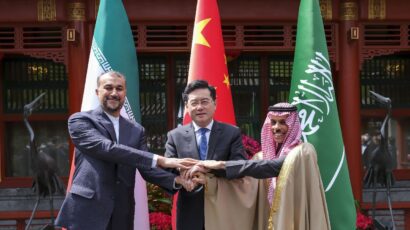Asia’s space race
By Dingli Shen | October 30, 2007
With China, Japan, and India rapidly increasing their space programs, the international community should establish guidelines to ensure that the space pursuits of all countries remain peaceful.
Appropriately enough, China launched its first moon-orbiting spacecraft, the Chang’e 1 (named
after the Chinese goddess of the moon) on October 24, only a month after its Moon Festival, an
annual, 3,000-year-old celebration scheduled to coincide with the autumn equinox and marked with
“moon cakes.” The launch represents another effort by China to assert itself as an emerging global
power.
Despite the chaos of the Cultural Revolution, China launched its first Earth-orbiting satellite
in 1970. Even though it was far less developed and technologically advanced then, China’s planned
economy could still efficiently make strategic decisions and effectively invest its resources. In
addition, unlike other regional powers, Western containment forced China to develop independent
defense and strategic capabilities; in comparison, India was highly dependent upon the Soviets for
advanced defense technology.
Nearly a quarter century after the start of China’s reform age, Beijing’s space program has
ushered in a new technological era: In 2003, China shot its first “Chinanaut,” a Chinese astronaut,
into space, and earlier this year, China garnered attention and caused a controversy by destroying
a defunct weather satellite in space. Now, it’s the Chang’e 1. As for the future, the government
appears to be readying a landing probe that it will send to the moon, and possibly, even a
Chinanaut.
The lunar probe is not meant to compete with the United States, the world’s preeminent space
power. Washington sponsored the first human landing on the moon in 1969, while China has only shot
its first moon-orbiting instrument into space. Even if Beijing is lucky enough to send a Chinanaut
to the moon in the next two decades, it will be 50 years after Neil Armstrong first walked the
moon. That’s a significant gap.
China also finds itself in a regional space race of sorts. A few weeks ago, after a delay of
four years, Japan sent its Kaguya spacecraft to the moon. That and Chang’e 1’s launch will
certainly inspire India to hasten its space program. The three rising Asian powers are now
empowering themselves via their space pursuits. On this count, Japan and China are clearly ahead of
India. Their space activity might also be motivating NASA, which recently announced it will also
launch a moon orbiter in 2008 and return to the moon within 10 years.
As for India, it used a Soviet rocket to send its first satellite into space in 1975; five years
later, it succeeded in using its own rocket to do so. In April, India launched its first commercial
satellite with an Italian payload, and it will launch its first moon orbiter in 2008, carrying two
NASA devices.
What are the implications of such a competition? All three countries maintain that their space
pursuits are purely scientific in intent. The Kaguya spacecraft will map the moon’s surface, while
the Chang’e 1 will do the same (although more comprehensively) and analyze more than 10 of the
moon’s chemical elements. India’s orbiter will enable NASA to site the location of the next U.S.
manned lunar landing.
However, these civilian space programs could be developed as a hedge against a space military
hegemony, which many believe the United States wants to become. India has published its Space
Vision 2020, a report that demands Indian Armed Forces carry out 1,000 research projects to
determine its space capability in intelligence, surveillance, reconnaissance, detection,
communication, and navigation. Accordingly, last year, the Indian Air Force started preparing for a
space command. Though the viability of such an ambitious plan is suspect, New Delhi must feel an
impetus to strongly pursue a space race in both civilian and military programs.
Therefore, an international agreement ensuring space is used for peaceful purposes only is more
essential today than ever before. But since space technology can mean big economic gains in the
global marketplace and space dominance can lead to a strong national defense, striking such an
agreement will be difficult. Consequently, humankind faces a dilemma. A rush for
scientific/technological achievement and national pride is leading Asia’s civilian space race.
That’s the positive influence of U.S. space accomplishments. But if Washington isn’t careful, its
future space activities (if military in nature) could set a negative precedent, leading to an arms
race in space between many different nations if Asia’s race to the moon is any indication. All the
more reason for the international community to agree to a code of conduct in space sooner rather
than later.
Together, we make the world safer.
The Bulletin elevates expert voices above the noise. But as an independent nonprofit organization, our operations depend on the support of readers like you. Help us continue to deliver quality journalism that holds leaders accountable. Your support of our work at any level is important. In return, we promise our coverage will be understandable, influential, vigilant, solution-oriented, and fair-minded. Together we can make a difference.
Topics: Columnists















